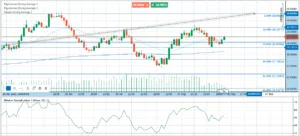-
Best Forex Brokers
Our top-rated Forex brokers
-
Brokers for Beginners
Start trading here
-
Forex Demo Accounts
Learn to trade with no risk
-
ZAR Trading Accounts
Save on conversion fees
-
Lowest Spread Brokers
Raw spreads & low commissions
-
ECN Brokers
Trade with Direct Market Access
-
No-deposit Bonuses
Live trading with no deposit
-
High Leverage Brokers
Extend your buying power
-
Islamic Account Brokers
Best accounts for Muslim traders
-
Market Maker Brokers
Fixed spreads & instant execution
-
All Trading Platforms
Find a platform that works for you
-
TradingView Brokers
The top TradingView brokers
-
MetaTrader4 Brokers
The top MT4 brokers in SA
-
MetaTrader5 Brokers
The top MT5 brokers in SA
-
cTrader Brokers
The top cTrader brokers in SA
-
Forex Trading Apps
Trade on the go from your phone
-
Copy Trading Brokers
Copy professional traders
The USD/ZAR has been on a wild ride this summer, and with the US Federal Reserve’s unclear stance on interest rates and the flagging Chinese economy, the turbulence is not over.
Local factors are also at play of course. The South African economy’s travails were brought into sharp focus on Tuesday, as National Treasury figures showed that the budget moved to a deficit of R143.8 billion ($7.74 billion) in July, the largest since at least 2004 and wider than the R115.5 billion predicted by analysts. The Rand promptly fell 0.8% against the US dollar, finishing the day at R18.58.
South Africa’s Central Bank Governor, Lesetja Kganyago, expressed concern in parliament, citing high levels of fiscal risk. In June, the bank also noted growing unease from local investors as they struggled to continue absorbing government issuance. Demand at Tuesday’s government bond auction was the lowest in nearly two years, based on data compiled by Bloomberg.
The South African Reserve Bank, like most central banks, has spent the last eighteen months fighting skyrocketing inflation. One of the first emerging market economies to start the fight against inflation, South Africa has raised interest rates by 4.75% since 2021. SARB finally called time on inflation hikes in July, leaving the interest rate at a record 8.25%.
While ostensibly fighting inflation, SARB has also found itself defending the Rand by attempting to keep up with the aggressive monetary policy set by the US Federal Reserve. It should come as no surprise that the decision to pause a hike in interest rates followed the same decision by the FOMC in the US.
With inflation now at the upper end of SARB’s target zone of 3-6% it appears that interest rate hikes will no longer be supporting the Rand. And without further hawkish monetary policy, the fundamental outlook appears grim.
The spectre of further interest rate raises in the US is keeping the USD buoyant, and with 15% of South African exports reliant on weakening Chinese demand, it’s hard to see where ZAR bulls will get their good news from. The recent BRICS meeting didn’t seem to help matters either, with foreign investment outflows reaching R2.87 billion as the summit concluded.
On the Technical Front
In the short term, the USD/ZAR seems to be on a bullish run with the price having just crossed above the 26 – EMA (light blue) and the 50-EMA (pink). The RSI also crossed above the 50% level, indicating a neutral to increasing upward momentum. As mentioned, this bullish stance is backed up fundamentally by the halt in interest rate hikes by the SARB and the National Treasury figures. Strong resistance is located at R19.20 level, while traders will find support at the 23.6% Fibonacci level at 18.5526.
USD/ZAR Daily Chart:

The longer-term chart also doesn’t bode well for the ZAR, as the ascending price channel that started in June 2021 continues with its upward momentum.
USD/ZAR Weekly Chart:

Stay updated
This form has double opt in enabled. You will need to confirm your email address before being added to the list.




























